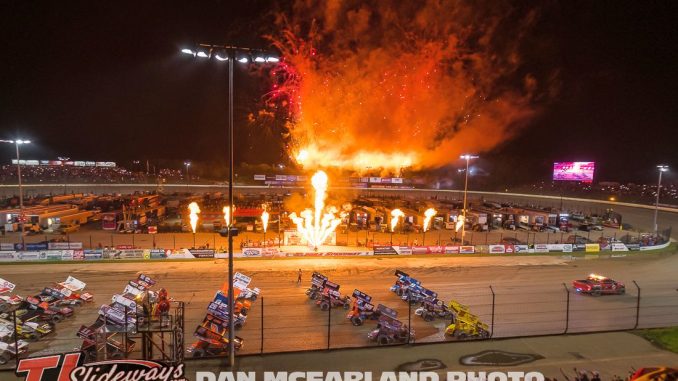
By T.J. Buffenbarger
(July 16, 2024) — The Kings Royal uses a format unique to Eldora Speedway that has a close resemblance to the World 100 and Dream before those became multiple day programs. The format has remained largely unchanged since the event began.
The single day format creates one of the most unique challenges in sprint car racing where teams are making critical decisions on strategy before they even hit the racetrack. One of those decisions is how to approach qualifications. Some drivers opt to turn the fastest lap possibly, while others are mysteriously slower in qualifying than they are on any other race night.
While it’s rare if ever you hear a driver on the record admit they sandbag/ detune their car as an attempt to qualify in the sweet spot to land near the front row of a heat race.
How does the format work?
To understand the challenge, first you must understand the format.
The entire field qualifies against each other in a single group, the best of two laps counting as that driver’s time. The field is then divided into six heat races with the fastest six cars inverted by their qualifying times. The fastest overall qualifier starts sixth in the first heat race, and so on.
This is where things get more complex, and the chart below should help clarify as we move forward on how the feature is lined up based on heat race finish.
1. Heat Race #6-P1
2. Heat Race #5-P1
3. Heat Race #4-P1
4. Heat Race #3-P1
5. Heat Race #2-P1
6. Heat Race #1-P1
7. Heat Race #1-P2
8. Heat Race #2-P2
9. Heat Race #3-P2
10. Heat Race #4-P2
11. Heat Race #5-P2
12. Heat Race #6-P2
13. Heat Race #1-P3
14. Heat Race #2-P3
15. Heat Race #3-P3
16. Heat Race #4-P3
17. Heat Race #5-P3
18. Heat Race #6-P3
19. Faster Qualifier #1
20. Faster Qualifier #2
21. B-Main P1
22. B-Main P2
23. B-Main P3
24. B-Main P4
The top three finishers in each heat race transfer to the feature event. The winner of the sixth heat race starts on the pole for the main event while the winner of the first heat race starts sixth. All the second and third place finishers in their heat races start straight up based on their finishing position and heat race number. The fastest two qualifiers that do not transfer through their heat race get the 19th and 20th starting positions.
Heat Race finish also determines the B, C, and D-Main lineups without the inversion similar the same way the A-Main is lined up.
How did the winners perform?
With the deep inversion and so much riding on heat race finish, some drivers will attempt to “sandbag” during qualifying lap to seed themselves in the best position to win a heat race. If you look at the numbers over the past 11 Runnings of the Kings Royal, six of those drivers qualified in the top six positions, making them the fastest car in their heat race.
| Year | Winner | Qual. Pos. |
| 2023 | Donny Schatz | 24 |
| 2022 | Brent Marks | 19 |
| 2021 | Kyle Larson | 21 |
| 2021 | Tyler Courtney | 5 |
| 2019 | Brad Sweet | 18 |
| 2018 | Donny Schatz | 21 |
| 2017 | Donny Schatz | 1 |
| 2016 | Donny Schatz | 4 |
| 2015 | Shane Stewart | 2 |
| 2014 | Kerry Madsen | 1 |
| 2013 | Brad Sweet | 35 |
Over this 11 edition span the average qualifying position for the winner is just under 14th, but the last three editions of the Kings Royal the the winner’s average qualifying position was just over 21st.
There is some risk trying to hit the sweet spot in qualifying in the middle or tail end of the 36 cars that make up the invert. If one were to fall out of that range it greatly increases the chance of not transferring through the heat race. Being in the sweet spot of 30-36 puts you on the pole for the heat race, but qualifying first through sixth gives you a better chance of having positions 19 and 20 to fall back to avoid having to run the B-Main. The numbers show though that strategy works out just as well as being among the fastest qualifiers over the 11 event span.
The argument for playing the qualifying game is over this 11 edition span the average qualifying position for the winner is just under 14th, but the last three editions of the Kings Royal the the winner’s average qualifying position was just over 21st.
The surprising part about this table is the fact only two drivers qualifying in the teens won the Kings Royal in this time frame, and they qualified in the later part of the teens.
How did the fastest qualifiers fare?
Another argument for the sandbagging/detuning strategy is the past three years the fastest qualifying winner was Marks in 2022 qualifying 19th and only once in the past six editions of the Kings Royal has one of the top six qualifiers gone on to win the event.
Why would drivers want to play the qualifying game and risk not making the Kings Royal? One reason is evident when you look at how the top two qualifiers have fared since 2013.
| Year | Driver | Qualifying Position | Heat Race Finish | Feature Start | Feature Finish |
| 2023 | Justin Peck | 1 | 4 | 19 | 19 |
| 2023 | Rico Abreu | 2 | 5 | 20 | 6 |
| 2022 | Justin Peck | 1 | 4 | 19 | 19 |
| 2022 | Brad Sweet | 2 | 2 | 8 | 11 |
| 2021 | Brock Zearfoss | 1 | 4 | 19 | 22 |
| 2021 | Paul McMahan | 2 | 4 | 20 | 24 |
| 2021 | Brian Brown | 1 | 3 | 13 | 10 |
| 2021 | Dave Blaney | 2 | 5 | 19 | 20 |
| 2019* | Sye Lynch | 1 | DNS | 19 | 21 |
| 2019* | Logan Schuchart | 1 | 1 | 12 | 2 |
| 2018 | Christopher Bell | 1 | 2 | 7 | 23 |
| 2018 | David Gravel | 2 | 3 | 14 | 8 |
| 2017 | Donny Schatz | 1 | 1 | 6 | 1 |
| 2017 | Jason Sides | 2 | 5 | 19 | 20 |
| 2016 | Kerry Madsen | 1 | 5 | 19 | 15 |
| 2016 | Christopher Bell | 2 | 3 | 14 | 21 |
| 2015 | Bryan Clauson | 1 | 3 | 13 | 13 |
| 2015 | Shane Stewart | 2 | 3 | 14 | 1 |
| 2014 | Kerry Madsen | 1 | 2 | 7 | 1 |
| 2014 | Chad Kemenah | 2 | 2 | 19 | 14 |
| 2013 | Paul McMahan | 1 | 3 | 13 | 18 |
| 2013 | Joey Saldana | 2 | 4 | 1 | 22 |
* Indicates the year the “Joust’ was held, and the heat race order was chosen by the participating drivers based on finishing position in the event.
Since 2013 only three drives have set fast time and won the Kings Royal, which has not occurred happened since Donny Schatz did it in 2017. The average finishing position for one of the two fastest drivers in qualifying during that period in the feature is 14th. When looking at those numbers, one cannot blame drivers for trying to put themselves in a better position to win the Kings Royal by sandbagging in qualifying.
What about the two spots set aside for the fastest two qualifiers that don’t transfer through the heat race?
One could argue being one of the fastest two qualifiers in the field benefits that driver because they already have the 19th and 20th starting positions at their disposal.
| Year | Driver | Qualifying Position | Starting Position | Finish |
| 2023 | Brent Marks | 17 | 19 | 2 |
| 2023 | Rico Abreu | 2 | 20 | 6 |
| 2022 | Justin Peck | 1 | 19 | 19 |
| 2022 | Spencer Bayston | 4 | 20 | 16 |
| 2021 | Brock Zearfoss | 1 | 19 | 22 |
| 2021 | Paul McMahan | 2 | 20 | 24 |
| 2021 | Dave Blaney | 2 | 19 | 20 |
| 2021 | Paul McMahan | 7 | 20 | 16 |
| 2019 | Sye Lynch | 1 | 19 | 21 |
| 2019 | Tom Harris | 3 | 20 | 23 |
| 2018 | Jason Sides | 3 | 19 | 20 |
| 2018 | Sheldon Haudenschild | 4 | 20 | 21 |
| 2017 | Jason Sides | 2 | 19 | 20 |
| 2017 | Christopher Bell | 3 | 20 | 2 |
| 2016 | Kerry Madsen | 1 | 19 | 15 |
| 2016 | David Gravel | 3 | 20 | 11 |
| 2015 | Paul McMahan | 3 | 19 | 10 |
| 2015 | Brent Marks | 7 | 20 | 16 |
| 2014 | Chad Kemenah | 2 | 19 | 14 |
| 2014 | Cody Darrah | 7 | 20 | 16 |
| 2013 | David Gravel | 5 | 19 | 9 |
| 2013 | Craig Dollansky | 7 | 20 | 12 |
* Indicates the year the “Joust’ was held, and the heat race order was chosen by the participating drivers based on finishing position in the event.
While most drivers have not advanced very far through the field from row 10, last year Brent Marks and Rico Abreu made nice charges through the field when having to fall back on those assured starting positions. Christopher Bell was the only driver to land on the podium other than Marks after a spirited charge through the field in 2017. Outside of that trio of drivers David Gravel is the only other driver in this time frame that has cracked the top 10 with a 9th place run from 19th starting position in 2013.
If you look at where the drivers qualified that had to use those guaranteed spots and only one since 2013 was lower than seventh, which was Brent Marks last year. In the past five editions of the Kings Royal one of the fastest two qualifiers have failed to transfer through their heat race.
In conclusion…
There are years that a driver and team are locked in to the point that they are fast enough to qualify near the top of the order and win Kings Royal. In recent years the numbers have shown that some of the teams that did not qualify as well put themselves in winning positions.
The Kings Royal format does provide entertaining racing and gives a mid-level team that may not have the budget for an engine that qualifies well but can race themselves into a good position for Saturday’s feature.
In the end the cream does rise to the top, and Saturday’s driver that will end up wearing the crown and holding a $175,000 paycheck will have more than earned their victory.
